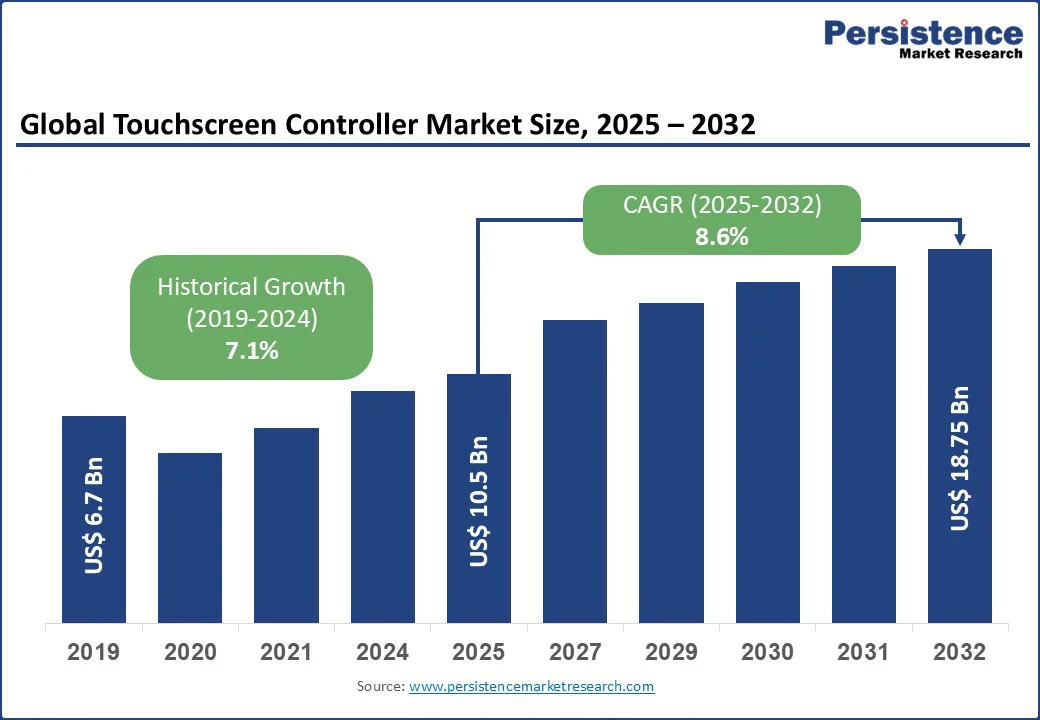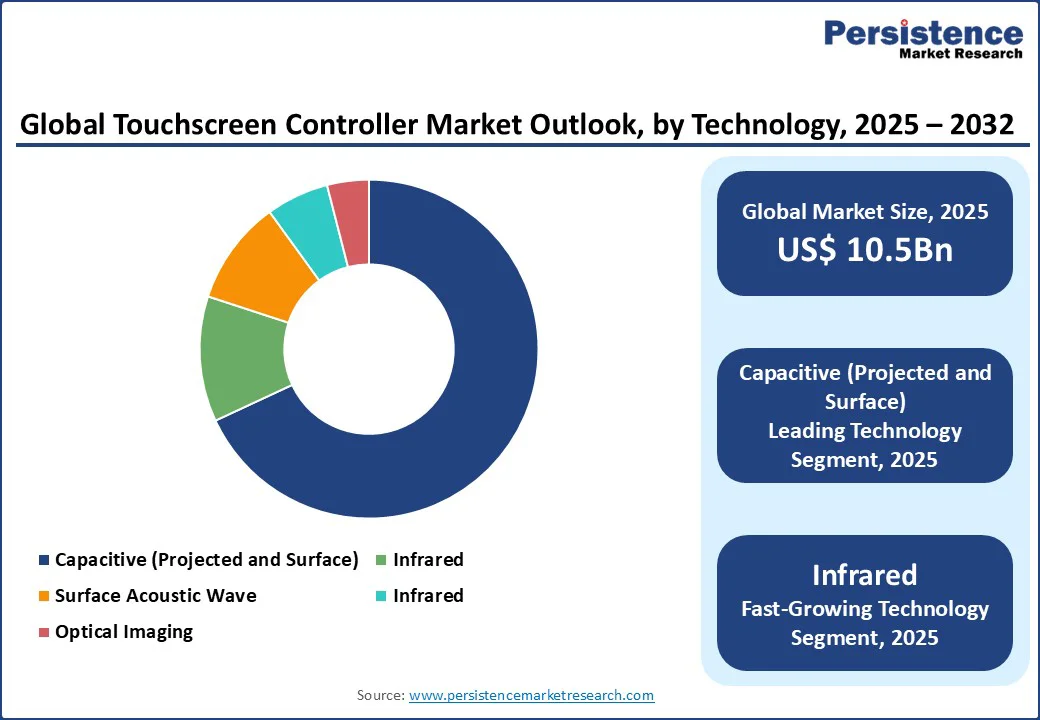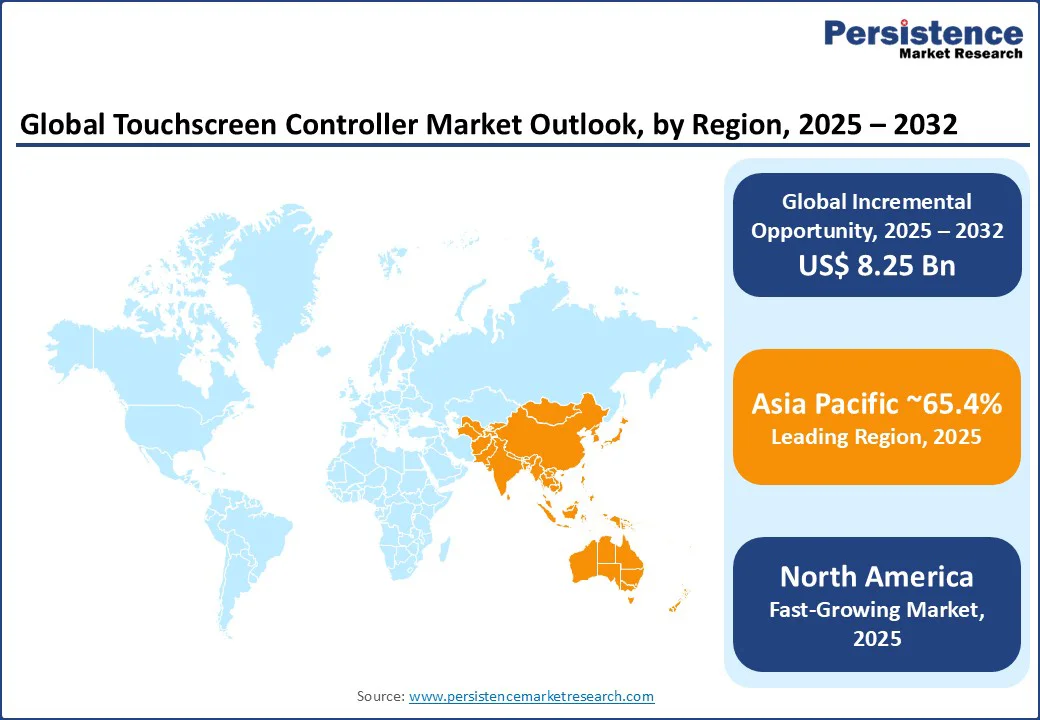ID: PMRREP12763| 180 Pages | 23 Sep 2025 | Format: PDF, Excel, PPT* | Semiconductor Electronics

The global touchscreen controller market size is expected to reach US$10.5 billion in 2025 and increase to US$18.7 billion by 2032, growing at a CAGR of 8.6% during the forecast period from 2025 to 2032. The market is experiencing robust growth, driven by the increasing adoption of touch-enabled devices across consumer electronics, automotive, and healthcare sectors.
Key Industry Highlights

| Key Insights | Details |
|---|---|
|
Touchscreen Controller Market Size (2025E) |
US$ 10.5Bn |
|
Market Value Forecast (2032F) |
US$ 18.7Bn |
|
Projected Growth (CAGR 2025 to 2032) |
8.6% |
|
Historical Market Growth (CAGR 2019 to 2024) |
7.1% |
The touchscreen controller market is expanding rapidly, driven by the growing adoption of touch-enabled devices in the consumer electronics sector. Devices such as smartphones, tablets, and wearables depend on responsive capacitive touchscreen controllers known for their high accuracy and multi-touch support. The emergence of foldable smartphones and bezel-less displays has further increased the need for advanced touchscreen solutions.
Tech giants such as Samsung Electronics and Goodix Technology have reported a notable rise in controller shipments in 2024, driven by the surge in 5G smartphone production in the Asia Pacific. Government-backed digitalization efforts are also fueling market demand. For example, India’s Digital India initiative has led to the installation of over 500,000 Common Service Centers (CSCs), many of which are equipped with touchscreen kiosks for public service access.
These trends underscore how innovation, rising tech adoption, and supportive policies are key drivers of the touchscreen controller market’s growth through 2032.
The touchscreen controller market faces challenges due to high development costs and competition from alternative input technologies. Designing advanced touchscreen controllers, particularly for capacitive displays, requires a significant investment in R&D for precision and compatibility with a diverse range of devices. The 2023 semiconductor supply chain disruptions and resulting price volatility further escalated production costs, disproportionately affecting smaller and mid-sized manufacturers.
Additionally, alternative technologies, such as voice recognition and gesture-based interfaces, are gaining traction, particularly in automotive and smart home applications. For instance, Amazon’s Alexa and Google’s gesture control systems pose competitive threats to touch-based interfaces. Moreover, the lack of standardization in some regions and concerns over touchscreen durability in industrial or outdoor environments limit broader adoption. These factors pose significant restraints, particularly in cost-sensitive markets, which could potentially slow the overall growth of the touchscreen controller industry.
The increasing integration of touch-enabled systems in the automotive and healthcare sectors presents significant opportunities for the touchscreen controller market. In automotive applications, touchscreen controllers are essential for infotainment systems, navigation displays, and advanced driver-assistance systems (ADAS). According to the IEA's Global EV Outlook 2023, the total fleet of EVs (excluding two- and three-wheelers) is expected to grow from nearly 30 million in 2022 to about 240 million in 2030 in the Stated Policies Scenario (STEPS), driving demand for robust touchscreen controllers.
In healthcare, touch-enabled medical devices, such as diagnostic monitors and surgical interfaces, rely on precise controllers to function effectively. Companies such as STMicroelectronics are developing controllers with enhanced durability for medical applications. Government incentives, such as the EU’s NextGenerationEU plan, support smart healthcare and automotive innovations, creating opportunities for manufacturers to develop advanced, reliable touchscreen controllers to meet evolving industry needs through 2032.

Asia Pacific is poised for a 65.4% share in 2025. This growth is largely driven by the region’s status as a global hub for consumer electronics manufacturing and rapid industrialization in key countries such as China and South Korea.
China, recognized as the world’s largest smartphone manufacturing hub, significantly drives demand for touchscreen controllers, supported by data from the China Electronics Industry Association. Meanwhile, South Korea’s thriving display industry, led by giants such as Samsung Electronics, pioneers advancements in capacitive touchscreen controller technologies. Additionally, India’s government-backed Digital India initiative has accelerated the adoption of touch-enabled kiosks and smart devices across both the public and private sectors.
The region’s strong semiconductor ecosystem and ongoing smart manufacturing initiatives further strengthen its leadership position. These factors, combined, ensure sustained growth and innovation throughout the forecast period, up to 2032.
North America is emerging as the fastest-growing region, propelled by robust demand from the automotive and healthcare sectors. The U.S. automotive industry extensively integrates touchscreen controllers in infotainment systems and Advanced Driver Assistance Systems (ADAS), enhancing vehicle safety and user experience. Meanwhile, Canada’s expanding healthcare sector fuels the need for touch-enabled medical devices, as highlighted by the Canadian Medical Association, which emphasizes the importance of digital healthcare innovations to improve patient outcomes.
Leading companies such as Texas Instruments and Synaptics hold strong market positions in the region, leveraging extensive distribution networks to support innovations in automotive and healthcare technologies. Additionally, growing consumer preference for high-performance, durable, and responsive touchscreen controllers further strengthens North America’s foothold. Supported by advanced technological infrastructure and ongoing research and development, the region is poised to continue its rapid growth, meeting the evolving demands of both the automotive and healthcare industries well into the future.
Europe is the second-fastest-growing region, driven by stringent safety regulations and rising demand across the automotive and retail sectors. The European automotive industry heavily relies on touchscreen controllers for advanced infotainment systems, enhancing user experience and compliance with evolving safety standards. Key countries such as Germany and France are at the forefront of this growth, with Germany’s booming retail sector driving the adoption of touch-enabled POS terminals for seamless transactions.
Additionally, the EU’s NextGenerationEU plan supports innovation in smart healthcare and automotive technologies, boosting demand for reliable and high-performance touchscreen controllers. Industry leaders such as STMicroelectronics and NXP Semiconductors are continuously developing cutting-edge solutions to meet stringent regulatory requirements and rising consumer expectations.

The global touchscreen controller market is highly competitive, characterized by a fragmented landscape with numerous global and regional players. Leading companies such as NXP Semiconductors, Renesas Electronics, and Samsung Electronics dominate through extensive product portfolios and global distribution networks. Regional players, such as Goodix Technology, focus on localized offerings in the Asia Pacific. Companies are investing in advanced capacitive controllers and low-power interfaces to enhance market share, driven by demand in consumer electronics and automotive sectors.
The touchscreen controller market is projected to reach US$10.5 Bn in 2025.
Growing adoption of touch-enabled devices in consumer electronics and expanding applications in automotive and healthcare are the key market drivers.
The touchscreen controller market is poised to witness a CAGR of 8.6% from 2025 to 2032.
The rising demand in the automotive and healthcare sectors is the key market opportunity.
NXP Semiconductors, Renesas Electronics, Samsung Electronics, and Synaptics Incorporated are key market players.
| Report Attribute | Details |
|---|---|
|
Historical Data/Actuals |
2019 - 2024 |
|
Forecast Period |
2025 - 2032 |
|
Market Analysis |
Value: US$ Bn/Mn, Volume: As Applicable |
|
Geographical Coverage |
|
|
Segmental Coverage |
|
|
Competitive Analysis |
|
|
Report Highlights |
|
By Technology
By Interface
By End-use
By Region
Delivery Timelines
For more information on this report and its delivery timelines please get in touch with our sales team.
About Author